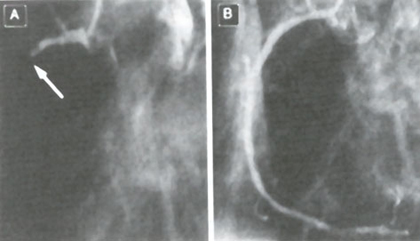
Figure 67
Coronary angiography before and after emergent angioplasty. Three months after registration, the patent had acute inferior myocardial infarction (inferior meaning as looking down at the stomach and intestines). Under these conditions (A) the coronary artery was totally occluded at the portion where the eccentric plaque with echolucent (a clear, dark rendition as opposed to a hard, white, filled-in effect) area had been seen by ultrasound. (B) Emergent balloon angioplasty that was done at the site of total occlusion resulted in complete recanalization (reopening) of this artery.
Yamagishi, M., MD, Terashima, M., MD, Awano, K., MD, Kijima, M., MD, Nakatani, S., MD, Daikoku, S., MD, Ito, K., MD, Yasumura, Y., MD, Miyatake, K., MD, Morphology of Vulnerable Coronay Plaque: Insights from Follow-up of Patients Examined by Intravascular Ultrasound Before an Acute Coronary Syndrome, Journal of the American College of Cardiology, Vol. 35, Jan 2000, p 106-111. (modified)